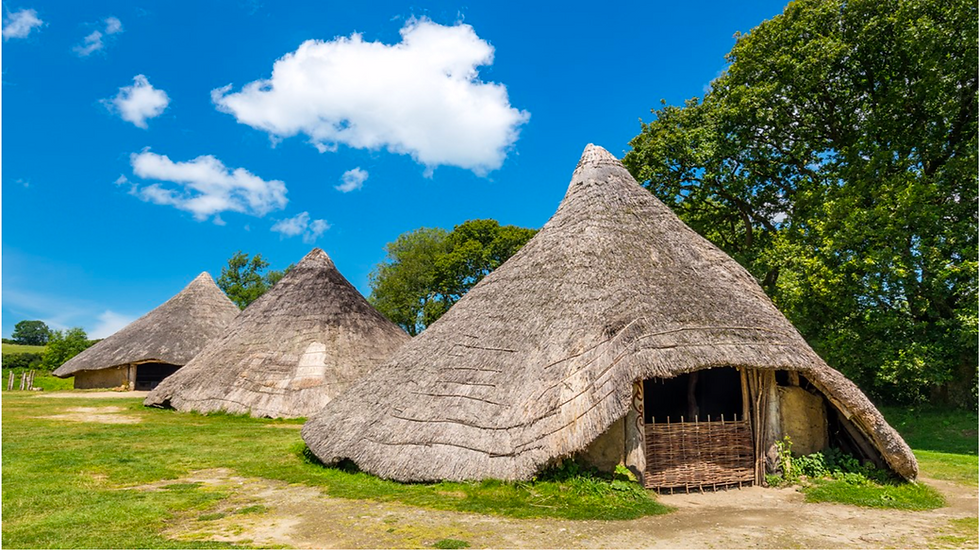What is archaeology?
- Lucy Jarvis
- Oct 14, 2020
- 3 min read
Updated: Jul 31
By James Meek BA (Hons) MCIfA

One definition of archaeology is the study of human history and prehistory, our heritage. This can be undertaken through excavation and analysis of sites, remains, artefacts, buildings and documents. Below is a timeline providing generalised dates for the various archaeological periods that we encounter in the UK.
The Neolithic, Bronze Age, Iron Age, Roman, Medieval and Post Medieval periods are probably the most well-known and those that archaeologists would be expected to deal with, a period covering almost 6000 years. But what is the earliest archaeology? And what is the latest archaeologists would be expected to deal with?
Human prehistory in Europe starts around 800,000 ago (note that dinosaurs became extinct some 65 million years ago and their study is the realm of the palaeontologist). The earliest human remains encountered are from the Palaeolithic or early stone age ranging from around 450,000 years to 12,000 years ago in the UK. Remains from this period are typically in the form of stone tools (mostly worked flint) and are relatively rare, although larger concentrations of material are apparent in some of the main river valleys of southern England. We know relatively little about the Palaeolithic due to the enormous time period it covers and the sparseness of remains found. The last few Ice Ages have removed much of the evidence that may have been present across most areas of the UK. A number of cave sites in England and Wales have produced good evidence for this early period and include cave paintings giving rise to the view of the ‘cave man’.

The Mesolithic period (middle stone age) 12,000 – 4000BC was the time of the hunter gatherer, nomadic groups moving across the land following their prey. This period is again most often represented by the recovery of flint and stone tools. By the Neolithic period (new stone age) between 4000 and 1800BC agriculture advances and more settled farming communities become established and a generally more relatable way of life arises.
But is there a point in time where remains would not be considered archaeology? The answer is no – not that it means every modern site would be archaeologically excavated! But there are modern remains that fit the some or all the criteria of being historically, archaeologically, culturally and architecturally significant.
Remains associated with the First and Second World Wars and the Cold War are good examples of 20th century features (often buildings or structures) which fit these criteria, being associated with periods of such enormous importance on an international scale. Such sites are of archaeological significance. Sites may range from the larger airfields and military bases of the Second World War, nuclear bunkers or missile launch sites (such as those formerly at Greenham Common) but also include smaller sites such as pillboxes, gun emplacements and lookout posts.
From my own personal experience, the latest site I have been involved in excavating and recording was built in the 1980s and demolished in 2017. This was a piece of experimental archaeology recording the sites of two reconstructed round houses at Castell Henllys Iron Age Village in Pembrokeshire. The buildings had been built directly upon the sites of original Iron Age round houses excavated and one of the aims was to compare the remains of the modern buildings and with what had been excavated originally excavated in the early 1980s[1]. The project also ended up providing some interesting evidence for the survival of plastic and sweet wrappers from visitors packed lunches.
Although the Castell Henllys project was very much research based and somewhat of an exceptional case, it does demonstrate that there is no real end date to archaeology, and if remains fit the criteria of being of archaeological, historical, cultural or architectural significance then there may be a requirement for archaeological recording if such remains might be impacted upon from development proposals.
Archaeology Collective (part of HCUK Group) has an experienced team capable of tackling archaeology of all periods. We work for developers to enable sites with archaeological potential to be developed. Our role is to be of service to the development industry, and we can provide advice from the earliest stages of proposed development, including evaluation, mitigation and post-excavation. Anything from prehistoric settlement through to late 20th century military buildings might be involved.
If you need advice on one of your projects, please contact:
James Meek: 07808 027 639 - james@hcukgroup.co.uk
Lorraine Mayo: 07587 062 369 - lorraine@hcukgroup.co.uk
.png)

Comments